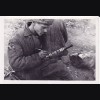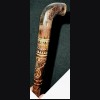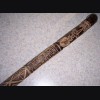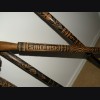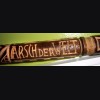The Wolchow Stick And Life In The Ass Of The World- Gaspare Bua # 1040
The walking stick has long been a feature in German culture, and for
centuries they have been observed throughout Europe in various form and
in the hands of some very prominent historical figures as well as the
common man.
The Wolchow stick is named for the Wolchow River region near St. Petersburg Russia. Known in WWII as Leningrad, this area of harsh terrain, swamp, and inhospitable conditions all around earned it the nickname "der Arsch der welt" or in English " The ass of the world ".
The sticks were reportedly carved by soldiers for their senior ranks, and by wounded who spent their time crafting these individual works of art into a remembrance piece for time spent in this area on the Russian front.
The wood used was indigenous to the area was a very hard blond or a local pine and each stick differs from the next with some more elaborate than others. The wood was very light weight and strong as well as resilient to the harsh environment. Some sticks may have been carved by Russian captives and in many cases swastika's will be found backwards and common German words spelled incorrectly.
Traditional early sticks are four sided with a top knob for the hand and taper from top to bottom. The sticks would bear geometric designs and Wehrmacht style eagles and various other treats making each one special in its own right. The square variants are less often encountered and the more common variant is a round stick, carved essentially in the same manner.
These were highly cherished pieces of the recipient, so much so that during direct veteran purchases where awards, equipment, and personal items such as rings are sold off, the sticks would remain with the owner and a refusal to part with them was not uncommon.
From the photo's, it is pretty clear that the men who had these sticks enjoyed them and in some cases sent them home for safe keeping, while others used them daily as their tough structure would bear the brunt of most anything.
While collectors in many cases gravitate to medals, firearms, cloth, and various things they feel are important artifacts, and of course they are. The fighting men who were there, tend to hold items such as the Wolchow stick or small tokens of their service as invaluable pieces of time, and only they know why. But it is their memory that dictates what was important to them, and the Wolchow stick was no doubt an important part of their service and memories of time spent in battle, in a place known as the ass of the world.
Note: It would appear that some question that Russian P.O.W's carved these sticks as the above article states. For those who have doubt I have added a period photo of a real Russian P.O.W carving a real stick. Picture is displayed 2nd from the last, this should clear the issue up.
Product Id: #1040
The Wolchow stick is named for the Wolchow River region near St. Petersburg Russia. Known in WWII as Leningrad, this area of harsh terrain, swamp, and inhospitable conditions all around earned it the nickname "der Arsch der welt" or in English " The ass of the world ".
The sticks were reportedly carved by soldiers for their senior ranks, and by wounded who spent their time crafting these individual works of art into a remembrance piece for time spent in this area on the Russian front.
The wood used was indigenous to the area was a very hard blond or a local pine and each stick differs from the next with some more elaborate than others. The wood was very light weight and strong as well as resilient to the harsh environment. Some sticks may have been carved by Russian captives and in many cases swastika's will be found backwards and common German words spelled incorrectly.
Traditional early sticks are four sided with a top knob for the hand and taper from top to bottom. The sticks would bear geometric designs and Wehrmacht style eagles and various other treats making each one special in its own right. The square variants are less often encountered and the more common variant is a round stick, carved essentially in the same manner.
These were highly cherished pieces of the recipient, so much so that during direct veteran purchases where awards, equipment, and personal items such as rings are sold off, the sticks would remain with the owner and a refusal to part with them was not uncommon.
From the photo's, it is pretty clear that the men who had these sticks enjoyed them and in some cases sent them home for safe keeping, while others used them daily as their tough structure would bear the brunt of most anything.
While collectors in many cases gravitate to medals, firearms, cloth, and various things they feel are important artifacts, and of course they are. The fighting men who were there, tend to hold items such as the Wolchow stick or small tokens of their service as invaluable pieces of time, and only they know why. But it is their memory that dictates what was important to them, and the Wolchow stick was no doubt an important part of their service and memories of time spent in battle, in a place known as the ass of the world.
Note: It would appear that some question that Russian P.O.W's carved these sticks as the above article states. For those who have doubt I have added a period photo of a real Russian P.O.W carving a real stick. Picture is displayed 2nd from the last, this should clear the issue up.
(The Wolchow Stick And Life In The Ass Of The World-Gaspare Bua)
REFERENCE ONLY. (SOLD or NOT FOR SALE)
The walking stick has long been a feature in German culture, and for
centuries they have been observed throughout Europe in various form and
in the hands of some very prominent historical figures as well as the
common man.
The Wolchow stick is named for the Wolchow River region near St. Petersburg Russia. Known in WWII as Leningrad, this area of harsh terrain, swamp, and inhospitable conditions all around earned it the nickname "der Arsch der welt" or in English " The ass of the world ".
The sticks were reportedly carved by soldiers for their senior ranks, and by wounded who spent their time crafting these individual works of art into a remembrance piece for time spent in this area on the Russian front.
The wood used was indigenous to the area was a very hard blond or a local pine and each stick differs from the next with some more elaborate than others. The wood was very light weight and strong as well as resilient to the harsh environment. Some sticks may have been carved by Russian captives and in many cases swastika's will be found backwards and common German words spelled incorrectly.
Traditional early sticks are four sided with a top knob for the hand and taper from top to bottom. The sticks would bear geometric designs and Wehrmacht style eagles and various other treats making each one special in its own right. The square variants are less often encountered and the more common variant is a round stick, carved essentially in the same manner.
These were highly cherished pieces of the recipient, so much so that during direct veteran purchases where awards, equipment, and personal items such as rings are sold off, the sticks would remain with the owner and a refusal to part with them was not uncommon.
From the photo's, it is pretty clear that the men who had these sticks enjoyed them and in some cases sent them home for safe keeping, while others used them daily as their tough structure would bear the brunt of most anything.
While collectors in many cases gravitate to medals, firearms, cloth, and various things they feel are important artifacts, and of course they are. The fighting men who were there, tend to hold items such as the Wolchow stick or small tokens of their service as invaluable pieces of time, and only they know why. But it is their memory that dictates what was important to them, and the Wolchow stick was no doubt an important part of their service and memories of time spent in battle, in a place known as the ass of the world.
Note: It would appear that some question that Russian P.O.W's carved these sticks as the above article states. For those who have doubt I have added a period photo of a real Russian P.O.W carving a real stick. Picture is displayed 2nd from the last, this should clear the issue up.
The Wolchow stick is named for the Wolchow River region near St. Petersburg Russia. Known in WWII as Leningrad, this area of harsh terrain, swamp, and inhospitable conditions all around earned it the nickname "der Arsch der welt" or in English " The ass of the world ".
The sticks were reportedly carved by soldiers for their senior ranks, and by wounded who spent their time crafting these individual works of art into a remembrance piece for time spent in this area on the Russian front.
The wood used was indigenous to the area was a very hard blond or a local pine and each stick differs from the next with some more elaborate than others. The wood was very light weight and strong as well as resilient to the harsh environment. Some sticks may have been carved by Russian captives and in many cases swastika's will be found backwards and common German words spelled incorrectly.
Traditional early sticks are four sided with a top knob for the hand and taper from top to bottom. The sticks would bear geometric designs and Wehrmacht style eagles and various other treats making each one special in its own right. The square variants are less often encountered and the more common variant is a round stick, carved essentially in the same manner.
These were highly cherished pieces of the recipient, so much so that during direct veteran purchases where awards, equipment, and personal items such as rings are sold off, the sticks would remain with the owner and a refusal to part with them was not uncommon.
From the photo's, it is pretty clear that the men who had these sticks enjoyed them and in some cases sent them home for safe keeping, while others used them daily as their tough structure would bear the brunt of most anything.
While collectors in many cases gravitate to medals, firearms, cloth, and various things they feel are important artifacts, and of course they are. The fighting men who were there, tend to hold items such as the Wolchow stick or small tokens of their service as invaluable pieces of time, and only they know why. But it is their memory that dictates what was important to them, and the Wolchow stick was no doubt an important part of their service and memories of time spent in battle, in a place known as the ass of the world.
Note: It would appear that some question that Russian P.O.W's carved these sticks as the above article states. For those who have doubt I have added a period photo of a real Russian P.O.W carving a real stick. Picture is displayed 2nd from the last, this should clear the issue up.
(The Wolchow Stick And Life In The Ass Of The World-Gaspare Bua)


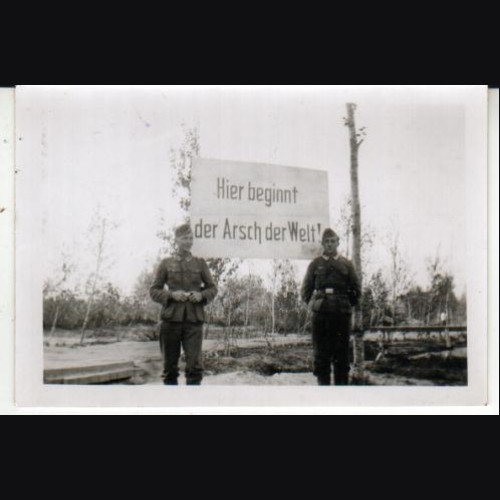
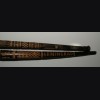
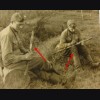
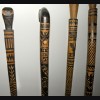
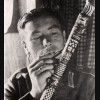
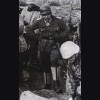
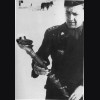
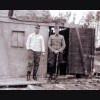
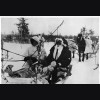
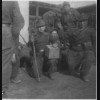
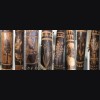
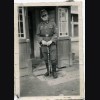
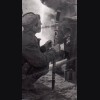
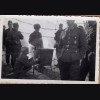
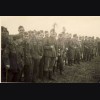
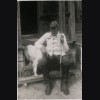
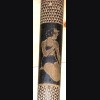
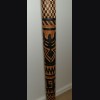
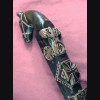
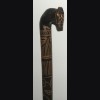
-100x100.jpg)
